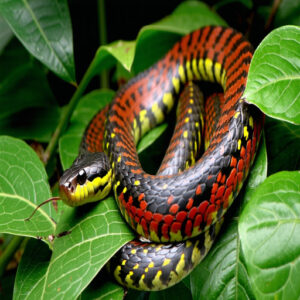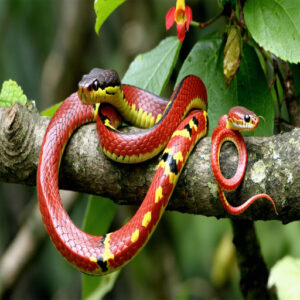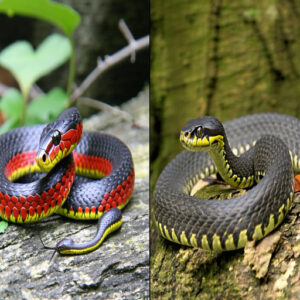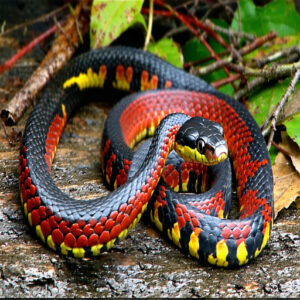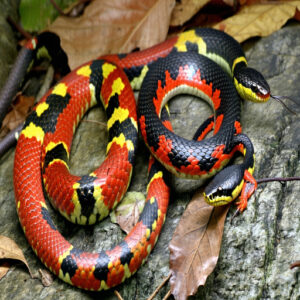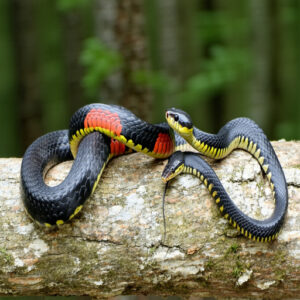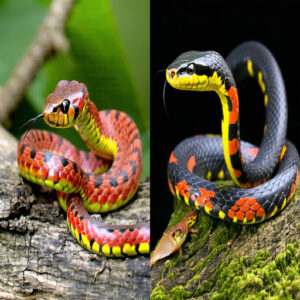This site is supported by our readers. We may earn a commission, at no cost to you, if you purchase through links.
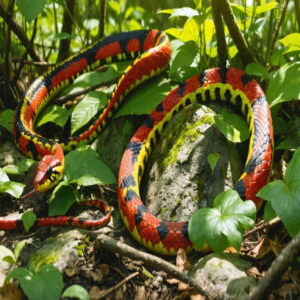 To identify a coral snake, focus on its vibrant colors and pattern.
To identify a coral snake, focus on its vibrant colors and pattern.
Their slender bodies are wrapped in red, yellow, and black bands, with red touching yellow—an easy “red and yellow, kill a fellow” rhyme to remember their venomous nature.
Unlike harmless lookalikes like the kingsnake, coral snake bands completely circle the body.
They’re shy, often hiding under debris, but when moving, they slither smoothly.
Watch for their small, rounded heads and black-tipped noses.
If you’re unsure, it’s safest to admire from a distance—better safe than sorry!
And trust me, knowing these key differences can be a lifesaver in the wild.
Table Of Contents
- Key Takeaways
- How to Identify a Coral Snake
- Differences Between Coral Snakes and Kingsnakes
- What Mistaken Identity is Common for Coral Snakes?
- Identifying a False Coral Snake
- Frequently Asked Questions (FAQs)
- How do you tell a coral snake from a venomous snake?
- What color is a coral snake?
- How do you know if a coral snake is a king snake?
- How do you identify a false coral snake?
- How do you distinguish a Texas coral snake from a venomous snake?
- Do coral snakes have red bands?
- How do you tell if it’s a coral snake?
- What snake is mistaken for a coral snake?
- How do you tell the difference between a true and false coral snake?
- What color coral snake is poisonous?
- Conclusion
Key Takeaways
- Focus on the red, yellow, and black bands—if red touches yellow, it’s a venomous coral snake.
- Always look for complete belly bands, as coral snakes have unbroken rings, unlike imitators.
- Spot the black-tipped nose and short snout, which distinguish coral snakes from nonvenomous lookalikes.
- Remember the rhyme: "Red touches yellow" to identify them safely, which goes as follows: "Red touches yellow, kills a fellow; red touches black, friend of Jack
How to Identify a Coral Snake
Spotting a coral snake starts with understanding its signature red, yellow, and black banding pattern, where red touches yellow.
Pay close attention to its small head, round body, and distinctive complete ring markings that stretch across its belly.
Color and Pattern
Spotting a coral snake boils down to noticing its distinct ring formation and vivid colors. The key? It’s all about the color pattern of coral snakes. Coral snake colors include red and yellow rings that touch—unlike the scarlet king snake, where red and black rings meet instead.
Their belly bands (the banding extending underneath) are complete—a key sign. Also, coral snake markings feature tails with only black and yellow rings, while look-alikes keep consistent banding to the tip.
For more information on coral snake look alikes, understanding these differences is essential. Need quick tips? Memorize this rhyme: "Red touches yellow, kills a fellow; red touches black, friend of Jack."
- Ring Formation: Red touches yellow.
- Color Variance: Vibrant bands.
- Belly Bands: Fully encircle.
- Pattern Recognition: Tail differences.
Distinguishing Physical Features
To nail coral snake identification, focus on its distinct body shape and markings.
Coral snakes have a black head with a short snout—unlike imitators like the scarlet king snake, which sports a red head with a longer snout.
Check the coral snake’s trademark red, yellow, and black bands—red touches yellow here, a key physical characteristic that screams, “Stay back!”
Understanding coral snake behavior is vital for safe encounters.
On their bellies, those vibrant coral snake patterns continue as full bands, unlike imitator species.
Don’t forget: "Red touches yellow, kills a fellow; red touches black, friend of Jack.
Behavior and Movement
When you stumble across a coral snake, it’s usually not out for trouble—it’s shy and spends most of its life underground, practicing its fossorial behavior.
If threatened, though, its behavior patterns kick in: both its tail and head twitch to confuse predators.
Their snake movement is slow but deliberate, enhancing stealth in hunting.
Remember, patience helps in snake identification tips!
Differences Between Coral Snakes and Kingsnakes
You might think telling coral snakes and kingsnakes apart is tricky, but it’s easier than it seems if you know what to look for.
By focusing on their color patterns, venomous nature, and how they react when disturbed, you can confidently identify which is which and avoid any risky encounters, knowing the venomous nature of the snakes.
Color and Band Patterns
Coral snake identification can feel like solving a tricky puzzle, but it’s easier once you know what to look for.
Their trademark ring coloration and color sequencing are key.
Here’s how to spot the differences between coral snakes and their copycats, like scarlet king snakes: For more information on Wildlife Research, understanding the patterns and characteristics of coral snakes is vital.
- Pattern Variations: Coral snake markings feature red and yellow bands that touch, while scarlet king snakes have red and black bands touching instead.
- Belly Bands: Coral snakes have complete rings circling their belly, unlike imitators that break the pattern.
- Tail Bands: Coral snake tails show only black and yellow bands, keeping it simple.
- Mnemonic Trick: Remember, “red touches yellow, kills a fellow” and “red touches black, friend of Jack.”
Keep these snake markings in mind for safer encounters!
Venomous Vs. Non-venomous
Let’s clear up the venomous vs. nonvenomous question.
Coral snakes pack a deadly dose of neurotoxic venom, while kingsnakes are harmless constrictors. Never confuse them! Understanding the snake identification techniques is essential for safety.
| Feature | Coral Snakes | Kingsnakes |
|---|---|---|
| Venom Effects | Neurotoxic venom | None |
| Snake Bites | Deadly if untreated | Harmless |
| Toxic Levels | Extremely high | Nonexistent |
Misidentifications can cost safety! Keep your snake identification guide handy.
Behavior When Disturbed
When things get tense, coral snake behavior reveals some fascinating defensive quirks.
Unlike their more aggressive neighbors, coral snakes prefer escape tactics over confrontation. If cornered, they’ll often wag their tails or sway their heads—classic warning signals that say, “Back off!”
King snakes, meanwhile, don’t adopt such flashy threat displays. Instead, they’re quicker to bite when annoyed. Coral snakes rarely bite unless harassed, maintaining a cool demeanor despite being highly venomous.
- A flared temper won’t save you. Learn snake identification to avoid risky mistakes!
- Their fangs mean business, but their first move is retreat.
- Stay away from the wiggle—it’s not an invitation to play!
What Mistaken Identity is Common for Coral Snakes?
You’ve probably heard the rhyme about coral snakes, but their look-alikes, like the harmless scarlet kingsnake, can easily trip you up.
Knowing the key differences in band patterns and other features could save you a lot of unnecessary worry—or even a trip to the hospital.
Similar Species
Snake mimics like the scarlet kingsnake often confuse people.
Coral snakes and their reptile lookalikes share bold color patterns, but key details separate them.
Coral snakes have red and yellow rings that touch, a black head, and are venomous.
Meanwhile, scarlet kingsnakes show red and black touching bands, a red head, and are harmless.
Understanding coral snake look alike species is essential for accurate identification.
Remember this rhyme: “Red touches black, friend of Jack; red touches yellow, kills a fellow.”
Spotting these distinctions can literally save your skin!
Key Differences
Spotting the differences between a coral snake and a harmless imitator like the scarlet king snake can save you from unnecessary panic—or worse.
Let’s break it down:
- Snake Body Patterns: Coral snakes show red and yellow rings that touch, which isn’t just for show—it’s a warning sign. King snakes? Red and black rings touch instead. Think "red touches black, friend of Jack."
- Key Physical Characteristics: Coral snakes boast sleek black heads and shorter snouts. Kings, in contrast, typically have red heads and longer snouts.
- Behavior When Disturbed: Coral snakes may flash their tails or curl their bodies. King snakes don’t bother with the drama.
- Venom Effects: Coral snakes are venomous predators, unlike the harmless, non-venomous kingsnake. Memorize this: "red touches yellow, kills a fellow.
Identifying a False Coral Snake
You’ve probably seen snakes mimicking coral snakes with similar bright colors, but spotting the fakes isn’t as tricky as it seems.
By looking closely at their band patterns, head shapes, and other small details, you can separate harmless imitators from the venomous ones.
Comparison With Coral Snake
In regards to coral snake identification, real coral snakes mean serious business—highly venomous with red-yellow rings touching.
False coral snakes? A clever illusion. Snake mimicry helps them steer predators away, but they don’t carry venom like their deadly counterpart.
Understanding Snake Identification techniques is essential in distinguishing between the two. Watch those color patterns—this species distinction could save you!
Coral snake vs false coral snake: always prioritize caution.
Key Physical Characteristics
Identifying a false coral snake is all about noticing small but key details.
While their color schemes may mimic true coral snakes, their ring structures follow the rule: “red touches black, friend of Jack.”
Unlike coral snake markings for the venomous kind, their scale textures and head shapes can appear less striking.
Here’s what to watch for: Understanding coral snake look alike characteristics is essential for accurate identification.
- Incomplete rings on the belly differentiate them.
- Duller colors compared to true coral snakes.
- They lack true venom, so they’re harmless.
- More relaxed behavior, like not using tail tricks when startled.
Mastering these distinctions makes snake identification straightforward.
Frequently Asked Questions (FAQs)
How do you tell a coral snake from a venomous snake?
Think of coral snakes as nature’s warning sign—bright bands of red, yellow, and black.
Remember, “red touches yellow, kills a fellow.”
Their imitators, like milk snakes, swap patterns but won’t pack venom.
What color is a coral snake?
A coral snake shows off bold red, black, and yellow rings with red touching yellow—nature’s warning sign.
This vibrant pattern screams, “Stay back!”
Just remember, “Red next to yellow, kills a fellow.”
How do you know if a coral snake is a king snake?
A coral snake’s red and yellow rings touch,
while a king snake’s red and black rings meet.
Think “red next to yellow, kill a fellow; red to black, venom lack” to stay safe.
How do you identify a false coral snake?
A false coral snake fakes the bright "red touches yellow" pattern but often has incomplete belly rings or red and black touching instead.
Its imitation game keeps predators guessing, but it’s entirely harmless to humans.
How do you distinguish a Texas coral snake from a venomous snake?
You’ll spot a Texas coral snake by its red, yellow, and black rings arranged with red touching yellow.
It’s shy and rarely strikes, unlike rattlesnakes or copperheads, which are louder and look stockier.
Do coral snakes have red bands?
Oh, absolutely, coral snakes rock their iconic red bands like a bold fashion choice.
These red bands, bordered by yellow, scream "danger" in nature’s language, making sure predators—and curious humans—know not to mess around!
How do you tell if it’s a coral snake?
Look for wide red and black rings with narrow yellow ones in between.
Remember, “red touches yellow, kills a fellow.”
Check its belly; true coral snakes have complete bands, unlike their imitators. Simple!
What snake is mistaken for a coral snake?
People often confuse coral snakes with harmless lookalikes like scarlet king snakes, milk snakes, and false coral snakes.
The difference? Their ring patterns—remember, “red touches yellow, kills a fellow; red touches black, venom lack.”
How do you tell the difference between a true and false coral snake?
You can tell true coral snakes apart from false ones by their belly patterns—true corals have complete colored bands.
Also, remember the rhyme: “red touches yellow, kills a fellow; red touches black, venom lack.”
What color coral snake is poisonous?
A coral snake’s venomous coloring follows the "red touches yellow kills a fellow" pattern.
If the red rings touch black, you’re safe.
Remember, the rhyme keeps you protected when identifying these sneaky serpents!
Conclusion
Spotting a coral snake is like solving nature’s puzzle—focus on the vivid red, yellow, and black rings, especially if red touches yellow.
Remember their smooth movement, full-body bands, and black-tipped noses. Don’t confuse them with harmless kingsnakes; check the band pattern or stay back if unsure.
This coral snake identification guide gives you the tools to stay safe. When in doubt, observe from a distance and appreciate these fascinating creatures without risking a dangerous encounter, following the key rule that red touches yellow.

